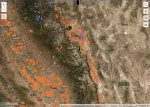The California Energy Commission (CEC) has created a map of proposed renewable energy sites in California with two alternatives. The CEC will be using it to plan all aspects of achieving California's SB100 goal of getting to 100% renewable energy of California's electricity system by 2045. This could require committing more than one million acres or more of land to renewable energy.
Comment deadline: 5:00 p.m. on November 1, 2022 (Instructions on how to comment at the bottom of this article.)
Here's the map that you can comment on:
https://experience.arcgis.com/experience/5504ca952f284b718b50f771ab287d67. It shows the proposed baseline solar sites to start with (the default when you open the map). To see the possible wind sites, click on the symbol that looks like a stack of paper in the upper right-hand corner. Click on the second arrow down, then on the Screen 1 Wind Resource Potential. To see the alternatives, click off the one you are on and then click on Screen 2 or 3 for solar or wind that you want to look at.

There are three maps:
- Screen 1 is the baseline map: orange for large-scale solar sites and blue for large-scale wind. It looks like this is mostly multi-use BLM or USFS land. It seems to be without regard for practical considerations, whether they are actually good sites for solar or wind development. It excludes slopes >10 degrees for solar. It doesn't look like they have excluded lands that have Eastern Sierra Land Trust easements or easements from other small land trusts, but should. If you know of any in your area, you should mention it.
- Screen 2 is Screen 1 minus land that has high level of being intact habitat or being near protected lands (wilderness, national parks, state parks, etc.).
- Screen 3 is Screen 1 minus land that has high biodiversity or climate resilience.
You can comment on Screen 2 and Screen 3 maps as well as on Screen 1 maps.
After this public input period, the map will be finalized and approved by the CEC in February. You might ask for a public review of the map after they have revised it based on this round of public input and before it is adopted by the IPER or is included in the CEC annual policy report coming out in February.
Some general comments one might make:
- There should be a cap on how many sites in a region can be developed. If all of the proposed sites on the map in Mono and Inyo Counties were developed, the impacts to wildlife would be devastating, wildlife migration corridors would be cut off, wetlands would be lost, ranching would be reduced affecting the local economy, and more.
- Some of the proposed sites are in remote areas, far from “the grid” or a substation where power lines don’t exist. To install power lines to connect these sites to the grid will come with additional, significant impacts.
- Some of the sites are small bits of land that will support only very small solar arrays or a few windmills that probably wouldn’t justify the cost of the infrastructure or even the cost of the project, especially in remote places. They should be taken off the table if they aren’t realistically viable locations.
How to comment:
Written comments must be submitted to the Docket Unit by 5:00 p.m. on November 1, 2022.
The CEC encourages use of its electronic commenting system. Visit the e-commenting page at https://efiling.energy.ca.gov/Ecomment/Ecomment.aspx?docketnumber=22-IEPR-02 which links to the comment page for this docket. Enter your contact information and a comment title describing the subject of your comment(s). Comments may be included in the “Comment Text” box or attached as a downloadable, searchable document consistent with title 20 of the California Code of Regulations, section 1208.1. The maximum file size allowed is 10 MB.
Written comments may be submitted by email. Include docket number 22-IEPR-02 and Land Use Screens in the subject line and email to docket@energy.ca.gov.
If preferred, a paper copy may be sent to:
California Energy Commission Docket Unit, MS-4 Docket No. 22-IEPR-02 715 P Street, Sacramento, California 95814-5512
Written comments, attachments, and associated contact information (including address, phone number, and email address) will become part of the public record of this proceeding with access available via any internet search engine.
More information on this topic:
California Energy Commission - Tracking Progress
TNC's projections are that California may need between 1.6 and 3.1 million acres of wind and solar by 2050 to decarbonize the electricity system and support the movement to “electrifying everything." - The Nature Conservancy: "Power of Place - California, Advancing a Clean Energy Future," Updated 10-5-22.